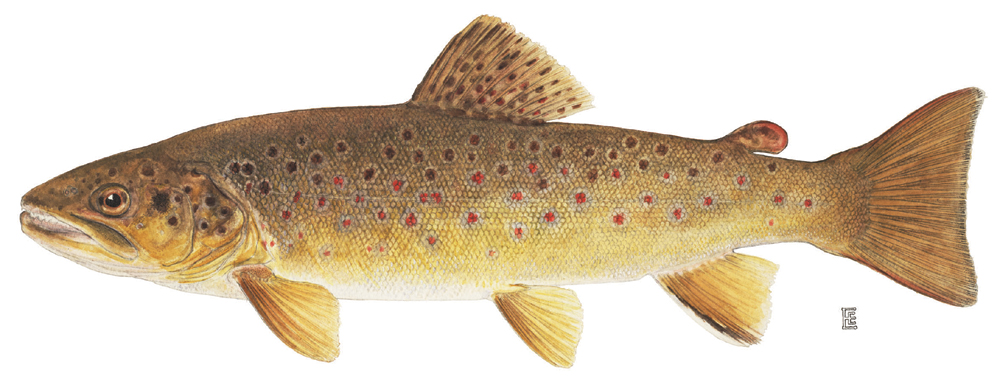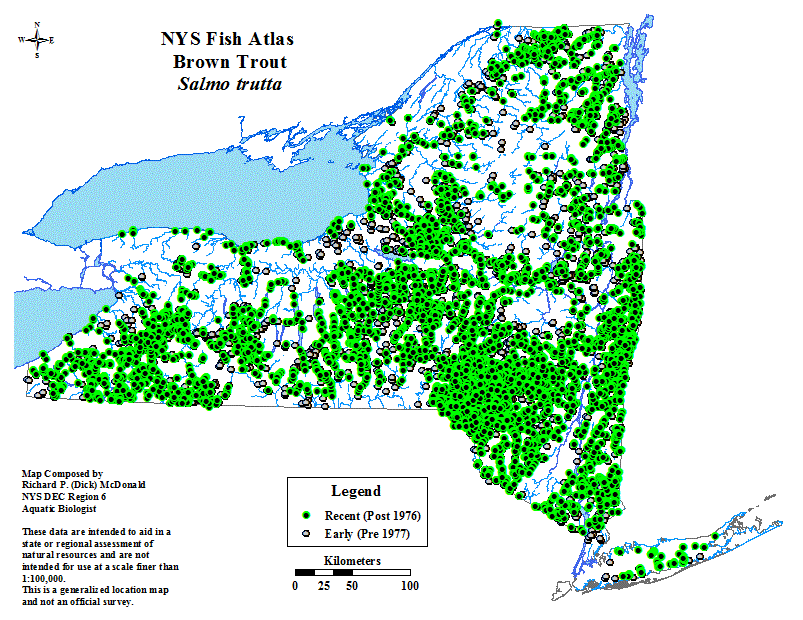
Brown Trout (Salmo trutta)
The brown trout is a native trout of Europe, praised by Izaak Walton. By 1850, fish culture was an established practice in western Europe, allowing brown trout to follow the flag of the British empire as part of the biological expansion of Europe, or what historian Alfred Crosby has coined "ecological imperialism." Brown trout were brought sequentially to India (1863), Tasmania (1864), Australia, New Zealand (1867), and South Africa (1876).
In 1883, an active fish culturist with the New York Fish Commission brought brown trout eggs from Germany to the Caledonia fish hatchery. The only earlier North American introduction occurred that same year, when German brown trout eggs reared at the Northville Hatchery, Michigan, were released into the Pere Marquette River of northern Michigan. Within less than five years, brown trout had been introduced into the storied BeaverKill in the Catskills, and eggs had been distributed to hatcheries throughout the U.S. Brown trout were ultimately introduced into 45 of the 50 American states, and are self-sustaining within 34 of these. Widespread Canadian introductions of brown trout also occurred at a similar pace during the late 19th Century.
Presently, the brown trout is found in a wide variety of New York waters, from brooks and rivers to large lakes and reservoirs. Most common in coldwater streams where they seldom reach lengths greater than 20 inches, brown trout are stocked in coastal waters of Lakes Erie and Ontario, where they can grow as large as 20 pounds. Their life history and behavior in the Great Lakes is similar to that observed in coastal northern European rivers along the Baltic Sea, where brown trout migrate into the ocean from coastal rivers. These anadromous brown trout can remain at sea for several years where they grow to sizes much larger than stream-resident brown trout, much like their close relative and member of the same genus, the Atlantic salmon (Salmo salar).
Brown trout spawn from October to December in waters ranging in size from large streams to small tributaries. The female builds a saucer-shaped redd, or nest, in the gravel substrate of a stream. Lake-dwelling brown trout migrate back to tributary streams in order to spawn, though unlike Pacific salmon, brown trout do not always die after returning to spawn. After the eggs are fertilized the female covers them with fine gravel, then fry hatch the following spring.
Throughout their lives, brown trout feed on the larval and adult forms of aquatic and terrestrial insects. Larger brown trout feed extensively on other fish, as well as other available vertebrates such as frogs. By comparison with other stream trout, brown trout are considered to be a greater challenge to catch.
Brown trout reflect a dilemma inherent in efforts to manage 21st Century fish communities and fisheries. To many anglers, brown trout represent the only trout that they have regularly caught in many accessible waters. Furthermore, these fish are often the largest stream trout available, though non-native rainbow trout also provide a similar reward. Yet improvements in water quality regulations since the 1970s and reforestation of large watersheds has made it possible for native brook trout to thrive, once again, in their native waters. Yet these smaller, native brook trout are unable to compete successfully with their European cousins, and are often considered unwelcome or ignored in stream restoration efforts designed to establish self-sustaining fish populations.
Distribution of brown trout in NY state.
An image of the brown trout is also available for download.
